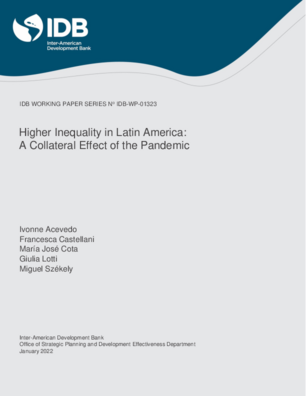Higher Inequality in Latin America: A Collateral Effect of the Pandemic
Date issued
Jan 2022
Subject
Equality;
Equality Indicator;
Pandemic;
Wage Gap;
Remittance;
Coronavirus
JEL code
D63 - Equity, Justice, Inequality, and Other Normative Criteria and Measurement;
I14 - Health and Inequality;
I32 - Measurement and Analysis of Poverty;
I38 - Government Policy • Provision and Effects of Welfare Programs;
O15 - Human Resources • Human Development • Income Distribution • Migration
Category
Working Papers
This study explores the evolution of inequality in Latin America during the COVID-19 pandemic using primary data available from household and employment surveys collected in 2020. Inequality increased on average by 2 percent between 2019 and 2020, twice the average annual growth in the inequality indicator that marked the decade of growing inequality in the 1990s. We obtained heterogeneous results when disaggregating by gender, urban/rural location, and sector of economic activity. Surprisingly, we found that the differences in income by education level declined in most cases. Remittances had a modest effect, while government transfers played a central role in preventing greater disparities in half the countries studied. Our estimations show that the decline in employment levels due to the economic contraction caused by COVID-19 is associated with increases in income inequality that we project will gradually diminish with the recovery. However, the lost schooling and losses in education attainment due to the pandemic may generate future pressures on inequality once school-age youth enter the labor market.
Generative AI enabled




